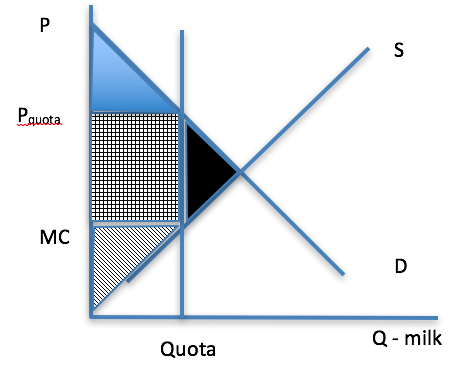Canada has a comparative advantage in agricultural production, meaning that we export most of our products. However, some products are protected via the quota system (e.g. dairy, poultry) meaning that production is held lower than what would be optimal under perfect competition. Canada does not typically export these products and the removal of any barriers to allow increased imports will likely hurt those producers (although consumers will gain). What does this mean for any trade agreements Canada negotiates? Should Canada opt to reject any deals or disallow imports of cheese from France, for example? How does supply management affect Canadian consumers?
Let’s first look at the notion of supply management. The Dairy Farmers of Canada (2016) say this about supply management on their website:
What is supply management?
Canada’s supply management system provides balance in the dairy sector by enabling Canadian dairy farmers to act collectively to negotiate price and adjust milk production to meet consumer demand.
While farmers around the world face unexpected and inexplicable wild market fluctuations, Canadian farmers sell their milk at constant and stable prices.
As a result, Canadian dairy farming is one of the few agricultural sectors that are self-sufficient – providing income security for farmers and requiring no government subsidy. This means Canadian farmers can invest in their farms, communities and Canada.
The first thing you might notice in the box presented above is something we have discussed already. The first statement talks about “fairness” or equity for dairy farmers. The box also discusses milk prices (p) and production (q), and demand (D), or the effects on markets. Furthermore, they allude to supply management being beneficial when there are shocks to the market (wild market fluctuations). And finally, the box says that dairy farming is one of the few sectors that is not subsidized. We will come back to these ideas shortly.

Figure 11-11: Supply management for dairy. Permission: Courtesy of course author Hayley Hesseln, Department of Agriculture and Resource Economics, University of Saskatchewan.
What the box does not tell us is what supply-management really means. The dairy industry regulates the amount of milk that can be produced using a quota system, thereby managing supply. More accurately, the dairy industry restricts supply below what could be produced in a free market.
Figure 11.11 illustrates how supply management works. Rather than being responsive to changes in price, the dairy industry chooses the quantity of milk to be produced (indicated by the vertical line marked “Quota”). Each dairy producer must purchase the right to produce and sell milk – in effect, they must purchase “quota.”
The result is a restriction of the total dairy supply below what would occur if quantity were allowed to fluctuate. Fixing the supply below equilibrium ensures that the price remains above what would occur under perfect competition (Pquota).
We can also look at the overall effects on diary producers and dairy consumers. The consumer surplus is the blue shaded area (smaller than under perfect competition), and producer surplus is the striped area under the marginal cost. Notice that at the quota amount, the marginal cost is read from the supply curve, whereas the price, or willingness to pay is read from the demand curve. Extra producer surplus is represented by the large rectangle. Because supply is restricted there is a deadweight loss to society as represented by the black triangle.
Let’s revisit the ideas expressed by the Dairy Farmers of Canada. They suggest that supply management is “fair” to producers. While producers certainly reap much greater benefits, we could question how this system is fair to consumers, who must pay higher prices for dairy products. What is equitable to one group is often not equitable to another. We could also question why grain farmers and cattle ranchers don’t restrict supply. Would this be a more equitable situation if they did?
The excerpt in the box also suggested that supply management is beneficial to dampen “wild market fluctuations.” Certainly, there are no supply fluctuations because the quantity is fixed. However, if there are demand fluctuations (increased population for example), the price will fluctuate more given the total inelasticity of supply. Finally, while the dairy sector does not receive subsidies from the government, it does command higher prices due to supply restrictions. So, either way, the public pays. Finally, the government restricts imports of dairy products to protect the dairy sector. While some products are allowed in, others must pay tariffs and duties to ensure prices are not lower than domestic products.
As you learned in the module on trade, free trade can lead to overall gains. What do you think the effects might be to the dairy industry under the Trans-Pacific Partnership if more diary imports are allowed? How might more trade affect consumers? See what CBC news has to say in figure 11-12.

Figure 11-12: News about possible effects to the dairy industry given the Trans-Pacific Partnership agreement. Source: https://www.cbc.ca/news/canada/montreal/tpp-dairy-imports-effects-1.3308877 Permission: This material has been reproduced in accordance with the University of Saskatchewan interpretation of Sec.30.04 of the Copyright Act.
In terms of debating supply management, consider whether Canada should keep it, or abolish it. What do you think the economic effects would be? Would it be better for society to have less-expensive dairy, cheese, poultry, and eggs? Are there ethical arguments against having high milk prices, particularly if it affects low-income people? Are there ethical arguments that support dairy producers?
We can also talk about what this means for animal welfare. Perhaps smaller dairy herds with more profits for diary producers mean that animals are treated better. It also might mean there are no added incentives from competition to innovate to become more efficient.
Finally, what does supply management mean for trade with other countries? There are many sources that support one side or the other. How will you construct your arguments to prove you are correct regardless of which side you are on?
